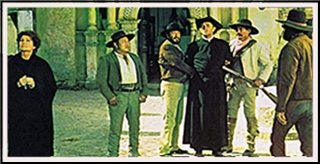May 2022
Monthly Archive
Mon 16 May 2022
Posted by Steve under
Reviews[2] Comments
REVIEWED BY TONY BAER:
RICHARD SALE – Benefit Performance. Simon & Schuster, hardcover, 1946. Dell #252, mapback edition, 1948.
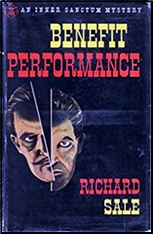
So, what it is, is a hardboiled Prince and the Pauper. I’m surprised I’ve never seen it before. It’s quite ingenious. Ingenuous? Maybe. But totally ingenious.
Kerry Garth, a well-known B-actor, is pooped. Just finished the wrap on three features in a row, two of which filmed simultaneously. The man needs a break.
But there’s the stupid premiere at Grauman’s Chinese Theatre. No freakin’ way.
Fortunately, Kerry’s got a spot-on stand-in: Joshua Barnes.
Pretty much an identical brother from another mother. Physically, anyway. A bit younger, but nothing a bit of Grecian Formula can’t fix.
For a C note, Barnes agrees to stand-in for Garth at the premier. As long as no one gets too close, no one will be the wiser.
At the premier, though, the unthinkable: Kerry Garth is assassinated! Assailant unknown!
Of course, the reader and Kerry know that it wasn’t the REAL Kerry Garth that got assassinated. But pretty much no one else knows!
Someone is trying to kill Kerry Garth–but Kerry has no idea who or why. He has no enemies that he knows of.
But one thing’s for sure. Being Kerry Garth ain’t too good for your health.
So Kerry’s only choice is to assume the identity of his stand-in: Barnes.
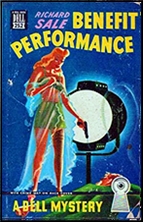
Unfortunately, Barnes turns out to be quite the unsavory character. The role isn’t too fun. And it’s unpaid. Hence, a ‘benefit performance’.
And Barnes turns out to be murder suspect #1 in the murder of Kerry Garth! So now the cops are after Kerry Garth for his own murder!!
Can he prove he’s really the prince and not the pauper? Or will he fry for a suicide he didn’t commit?
The book is slick, fast, fun and fabulous. The words just hum. Seamlessly. No seams.
Richard Sale and the best of the other hardboiled writers of the 20’s to 50’s were able to take language of ordinary working class Americans and make it sing.
Because I’m a pretentious bastard I’ll go on, though I need not, I am sure, to belabor the point I mean to belabor. And to accentuate my pretentiousness I’ll quote Wordsworth, who says of colloquial speech: “[T]he greatest Poet … must, in liveliness and truth, fall far short of that which is uttered by men in real life, under the actual pressure of those passions”. And Moliere: “These forty years now I’ve been speaking in prose without knowing it!”
Hardboiled writers like Sale streamlined ordinary speech patterns in this zenith of American culture to create an architecture of thought and story with crisp lines, moral clarity, and, most of all, sheer joy.
It’s a time machine to better times. Don’t miss it.
Some alternate takes:
https://mysteryfile.com/blog/?p=43471
https://davycrockettsalmanack.blogspot.com/2014/01/forgotten-books-benefit-performance-by.html
https://prettysinister.blogspot.com/2012/01/ffb-benefit-performance-richard-sale.html
Sun 15 May 2022
REVIEWED BY DAVID VINEYARD:
â— JACK HIGGINS – The Wrath of God. Originally published as by James Graham (Macmillan, UK, hardcover, 1971; Doubleday, US, hardcover, 1971; Dell, US, paperback, 1974).
â— THE WRATH OF GOD. (1972) Robert Mitchum, Ke.n Hurchinson, Victor Buono, Frank Langella, Rita Hayworth. Director: Ralph Nelson.
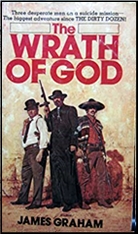
I may shock some here who know what a fan of the British adventure/thriller genre I am, but I stopped reading Jack Higgins after The Eagle Has Landed, his breakthrough bestseller and never went back. I dipped my toes in once in a while, but honestly I just was not interested. To me he was always the least of the major names in the genre, not in the same class as MacLean, Lyall, or Bagley and certainly not Innes, Household, and Canning.
Some of those later books I found nearly unreadable. Major bestselling writer, hugely popular, films, mini-series, but I had moved on. He just did not interest me anymore. I don’t even like Eagle, or the movie based on it.
As a writer, Higgins simply was not a good enough to get me to pull for German commandos trying to assassinate Churchill and their traitorous charismatic IRA helper. I’m just not sophisticated enough to enjoy an entertainment when I’m pulling for the main characters to be shot as soon as possible, not unless the writer is a hell of a lot more skilled than Jack Higgins was.
But noting his recent death I thought I would look at my favorite Higgins novel, because once upon a time I read him faithfully and had high hopes for him.
Higgins, real name Harry Patterson, was a school teacher who decided writing was more fun and paid better and went about it with a vengeance unseen since the heyday of the pulps. He had to manufacture multiple names to keep up with his output, mostly in around sixty thousand to seventy thousand word novels that moved fast, had attractive narrators, and exotic locations.
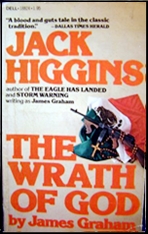
Those are far and away his most entertaining books, Night Judgment on Sinos, Year of the Tiger, A Game of Heroes, East of Desolation (my first), The Run to Morning, and Khufra Run are among the ones I would particularly single out from his his pre-Eagle output. They are not only good books, I’ve reread some of them recently and enjoyed them again.
Along the way he decided that it was more effort to churn out these fast moving short thrillers than to try for something bigger, and one of the names he experimented with in that endeavor was James Graham under which he wrote the fine flying adventure The Last Place God Made and this book, The Wrath of God.
Made has echoes of Nevil Shute, God of Graham Greene. The latter only just edges out the former in my estimation only because I like the fairly cheesy film based on it which I won’t really go into other than to say Robert Mitchum has fun as the phony priest who falls for his own con and Victor Buono gets what may be the only semi heroic role of his career.
I will not kid you it is a good movie, only that it is, for me anyway, a fun one despite the sad figure Rita Hayworth cuts in it as her failing health and mental state were becoming obvious.
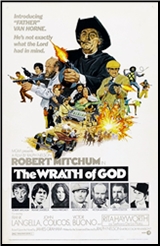
The place is Central America and the time is the 1920’s. The narrator is young ex-IRA gunmen Emmett Keogh for whom the world has become too small and the backwaters of hell seem a good place to lie low. At least they do until he meets Mr. Janos, a fat shady businessman with an ivory headed cane and Father, Oliver Van Horne, a charming American priest. Neither is what they seem. Janos sells illegal arms and Van Horne has a Tommy gun under his cassock and alternates between con artist and bank robber.
All three have run out of places in the world to be.
Which is how the three of them end up under arrest and blackmailed by Colonel Bonilla of the Army into helping topple a mad land owner turned warlord in the small village of Mojada and the surrounding region which is held in the grip of terror by Tomas la Plata, revolutionary, outlaw, madman, and would be dictator.
An army couldn’t pry him out of the region, but maybe a phony priest with a machine gun, an arms dealer, and an IRA gunman/sniper can.
It’s a fairly simple set up that goes back away, the good bad men vs the worse bad men. Arcs of redemption are put into action, tough seasoned hard cases are softened by decent people, love, and the plight of the innocent, and before it is over bloody hell will break out.
But it is written with brio and conviction, the narrator, Keogh, convincingly cynical, tough, and caught up in Oliver Van Horne’s greatest con and his own lingering shreds of idealism.
Writing a book using central casting isn’t always a bad idea.
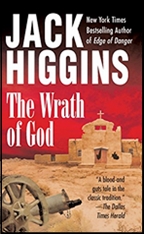
You can guess every turn of the plot well before it happens. There are no surprises here. Our “heroes†will consider stealing the silver hidden in Mojada and double crossing Bonilla, and of course end up doing the right thing while cursing themselves for doing it. Keogh, the youngest, will find love with a local girl.
I’ll go farther and point out that one of the delights of reading Higgins was how much he embraced the more obvious tropes of the genre. He wasn’t one for great invention of plot or character, he instead gave the reader what they wanted in the most straightforward manner possible moving so fast you couldn’t really complain that it was a good sandwich and not a filling meal.
His downfall came when he tried to convince readers it was a multiple course meal and he just didn’t deliver.
Frankly, when I stopped reading him was when he tried to do a bit more and I just didn’t think he really had the chops for it. This and The Last Place God Made are as far as he was really able to stretch himself in more serious terms, and truthfully he only just makes it, but credit where deserved in the end he does pull it off.
Maybe there wasn’t greatness there, but there was something more than the too slick bestselling writer he became. I would highly recommend every book I have mentioned here but The Eagle Has Landed, granting that most of you will probably disagree and may only know Higgins from his later better known works.
Sat 14 May 2022
RICHARD SALE “A Nose for News.†Daffy Dill #2. First published in Detective Fiction Weekly, December 1, 1934. Reprinted in The Hardboiled Dicks, edited by Ron Goulart (Sherbourne Press, 1965).

In this early entry in Richard Sale’s long-running series about newspaper reporter Daffy Dill, he loses his job at the Chronicle because of a revival reporter’s malfeasance: he managed to change the word “cook†in one of Daffy’s by-lined stories to ‘crook,†and the cook in question is boiling mad. Daffy’s editor at the paper has to let him go, but with promise that if he comes up with a story big enough, he’ll hire him back.
Top stories are hard to come by, of course, but after doing a favor for a young lady whose brother has gotten into trouble with gambling debts, she returns the favor by telling Daffy she’s going to falsely arrange a kidnapping story for herself in which Daffy will be required to be the go-between.
And of course you as the reader will immediately know that she will somehow end up being kidnapped for real. I don’t imagine that any such scenario would ever happen in real life, but I also think that any reader who has gotten this far into the story will go along with the gag and continue on anyway, sitting back and see just how Richard Sale gets Daffy Dill out of this particular jam.
Sale went on to wrote several dozen stories about Daffy Dill, mostly for Detective Fiction Weekly, but more than that he went on to become big name as a both a screenwriter and director. You can check out his Wikipedia page here.
Note: I first wrote a review of this story in 1967, and I posted it on this blog a few weeks ago. Follow the link and you can read it here.
Fri 13 May 2022
Posted by Steve under
Reviews[3] Comments
IT IS PURELY MY OPINION
Reviews by L. J. Roberts
S. J. TUDOR – The Burning Girls. Ballantine Books, hardcover, February 2021. Penguin, softcover, September 2021Setting: Sussex, England; contemporary.
First Sentence: “It’s an unfortunate situation.”

Reverend Jack Brooks and 14-year-old daughter Flo have been transferred to Chapel Croft in Sussex. A community with a very dark past including the burning of martyrs, disappearance of two girls, and the suicide of a priest. With no one being who they seem and not knowing who to trust, can Jack and Flo survive while exposing closely-guarded secrets?
The best books grab you from page one and don’t let go. This book does just that. One thing to know; there are a lot of bodies; new, old, spectral, and real. The story is more suspense than mystery, and never boring.
Tudor has a compelling voice. It’s engaging and conversational in both outward dialogue and internal thoughts. Jack and daughter Flo hold one’s attention and curiosity to know more. It’s nice that Flo acts appropriately for her age. However, both occasionally suffer from going into danger alone, yet both are also smart, brave and interesting.
Beyond the elements of voice and character, there are a plethora of memorable passages: another indication of a great author. Tudor makes one stop and think— “We all have our hiding places. Not just physical ones. Places deep inside where we put away the things we don’t want other to see.”
Rather than having an unreliable narrator, this is the case of “trust no one” in the best possible way. No one is who they seem and everyone has secrets.
There are an abundance of very effective plot twists and revelations from beginning to end. Some of them scare, some cause one to gasp, all of them surprise.
It’s hard to say much about the plot without saying too much and spoiling the suspense and the fun of reading it. The only problems were a couple silly, editing issues. Ignore them.
The Burning Girls is a great, escapist read, especially for those who like a bit of dark, eepy-creepy. There is a supernatural element, but doesn’t stop an enjoying an engrossing, page-turning book that keeps one reading way too late into the night, but one may want to leave the light on. The story holds one’s attention from first page to last and makes one happy Tudor has more books to read.
Rating: VG Plus.
Fri 13 May 2022
FRANK GRUBER “Death on Eagle’s Crag.†Oliver Quade #8. First published in Black Mask, December 1937. Reprinted in The Hardboiled Dicks, edited by Ron Goulart (Sherbourne Press, 1965).

At the beginning of this fanciful, not to mention far-fetched tale, Oliver Quade, also known as The Human Encyclopedia, has somehow found his way to an isolated resort located at the top of a mountain, doing what he does best: trying to sell the owner a set of encyclopedias. She may be better at resisting, though, than he isat selling them when one of the guests is found dead along a walking path.
Remains of a bashed-up rattlesnake are found beside him, with vicious bite marks on his leg, but Quade quickly deduces it was a well-planned murder. The resort’s handyman is about to head down to notify the authorities when a car full of gangsters, escapees from a local prison, comes driving up the hill. Coincidences pile up quickly. The dead man, as it turns out, was a thief,and once the gang of crooks realize he must have hidden eighty grand worth of stolen cash on the grounds, they decide to stick around and keep all of the real guests hostage while they look for it.
Even while it incorporates a small token of goofiness, making the story is quite a bit of fun to read, it is amazing how Gruber manages to turn the story around on itself as he does, making it perhaps the most violent one in The Hardboiled Dicks, the anthology of stories from the detective pulps Ron Goulart put together in the mid-sixties. There’s nothing very deep to this one, but somehow I’ve managed to remember the basic plot, all these many years later.
Oliver Quade, who manages to find the money while under a lot duress in this one, was in 15 stories in the pulps. He wasn’t quite as inventive as MacGyver was in using his head to get out of jams, but selling encyclopedias for a living obviously gave him a decided edge over a lot of tough bad guys in his day.
Note: I first wrote a review of this story in 1967, and I posted it on this blog a few weeks ago. Follow the link and you can read it here.
Thu 12 May 2022
WINDY CITY PULP CONVENTION 2022 REPORT
by Walker Martin
A few years ago, one of my best friends attended Pulpcon, despite knowing he had a terminal illness. Hardcore collectors will survive just about anything except death. My health problems lately have not involved a terminal illness, but I suffer from claustrophobia, and I had to undergo two cataract operations in April. Despite being disappointed in these procedures, I somehow managed to, go with four other collectors in our usual van.
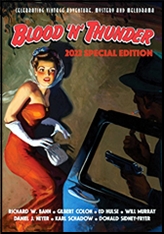
Fortunately, this convention managed to cheer me up and here are my comments on the Windy City Pulp Convention. There have been over 20 of these shows and this was the 15th year at the Westin Hotel in Lombard, Illinois, which is about a half hour outside Chicago. Doug Ellis stated that there were about 500 attendees and 180 dealer tables.
No masks were required, but many collectors wore them just to be safe. As usual the dealer’s room was very busy and set up was allowed on Thursday evening from 8 pm to about 11 pm. There were thousands of books, pulps, vintage paperbacks, original art, new pulp novels, movies on DVDs and comics.
Some excellent books made their debut at the show. Ed Hulse of Murania Press had what looked like his biggest magazine on the pulps, Blood n Thunder 2022 Special Edition:336 pages, over 100,000 words, and over 100 illustrations. There are 10 essays in the book with the most important being the 120 pages devoted to the Doubleday Crime Club Golden Age, 1928-1940. Ed also had a preview copy of his new book, an updated edition of Wild West in Fiction and Film.
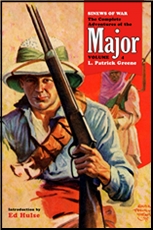
Matt Moring of Steeger Press had several new books for sale on Mike Chomko’s table: Unremembered Murder by Carroll John Daly, volume 7 of the Race Williams series, all from 1944-1955, The Major by L. Patrick Greene, volume 4, The Life of Pinky Jenkins by H. Bedford Jones, volume 3, and the best one of all, The Complete Exploits of the Notorious Sea Fox by James K. Waterman. This last collects several stories from Frontier in the 1920’s and deals with the infamous slave trade before the Civil War. Steeger Books has passed the 600 book mark I believe. Amazing and quite an accomplishment.
Also available was the new edition of the Windy City Pulp Stories, #21. 130 pages, all devoted to Fiction House. The best article was Will Murray’s “The Rise and Fall of Fiction House”. Also of note are articles dealing with Arthur J. Burks, the pulp magazine, Black Aces, and other Fiction House items of interest.
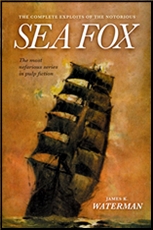
The art show had several original cover paintings and illustrations from Fiction House magazines and I was really impressed by the excellent display. Ed Hulse ran the usual film show which showed serials and B-movies during the day and after the evening auction.
Speaking of the auction, John Gunnison did his usual fine job as auctioneer. Friday night had 200 lots from the Robert Weinberg Estate and Saturday night had almost 200 lots from the Glenn Lord Estate. An entire set of Planet Stories was auctioned in several lots, many Weird Tales, including the Anniversary large issue from 1924 ($8000), and all sorts of correspondence. The Gent From Bear Creek by Robert Howard sold for several thousand.
There were the usual panels and I attended the Fiction House discussion given by Roger Hill. On Saturday night David Saunders did his usual excellent job discussing such Fiction House artists as George Gross, Allan Anderson, and Norman Saunders. I’m looking forward to his Pulpfest presentation on Nick Eggenhofer this August.

I’ve been collecting now for over 65 years and I don’t need much anymore, but I always find something. This year I’m rebuilding some of my sets such as All Western and Dime Detective. I found several copies of each that I need plus an Ace High from 1926 that I’ve been looking for.
One of the problems of collecting for a long time is that you start to run out of things to collect. Most of my wants are very odd and hard to find, such as the five Sea Stories I lack. There were 118 and I have 113, so it’s not too likely that I’ll find issues I need. Same thing with Western Story and Detective Story. I only need a few issues of each for complete sets, but I’ll probably never find them. But you never know. I never thought I’d find all 444 All Story either but I did.
Pulpfest is up next in August 4-7, 2022, in Pittsburgh. The 50th Anniversary of Pulpcon/Pulpfest! I never thought I’d see such a long run of conventions when I attended the first one in 1972. But here we are. See you there!
Thu 12 May 2022
Posted by Steve under
Reviews[11] Comments
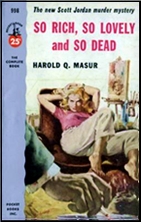
HAROLD Q. MASUR – So Rich, So Lovely, and So Dead. Scott Jordan #4. Simon & Schuster, hardcover, 1952. Pocket #998, paperback, 1954; cover art by; Stanley Zuckerberg. Dell D383, paperback, November 1961, as by Hal Q. Masur; cover art by Robert McGinnis. Pyramid #T2391, paperback, 1971.
The title refers to the first victim in this mystery, the fourth book appearance of defense attorney Scott Jordan. This is unfortunate, because I’d have liked to see her alive and well quite a bit longer. She is lovely, but while still young, has been married twice, and as a result of both marriages, is worth something in the order of ten million dollars. Rich, in other words.
And which is why she’s dead, and all too soon, because she also has a bit of sass to her. Someone wants her money – and control of her recently deceased uncle’s company – also worth a huge amount of money. But there is a catch. To obtain her inheritance she has to be married to an employee of the company by a certain date. And since her fiance’s divorce is not complete, she has to find a stand-in, a man who will agree to marry her for long enough to fulfill the provisions of the will, then step gracefully aside, well compensated, of course.
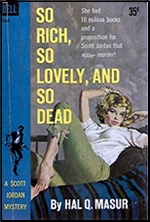
A problem arises, however, when she is murdered while still married to the stand-in. This is the legal problems begin – not quite as complicated in a Perry Mason story, but close enough.
One difference between Perry and Scott Jordan, is that the latter tells his own story, and he’s more active in the legal end of things, instead of manipulating the evidence, as the former is so wont to do. When it comes down to it, Perry leaves all the paperwork to Della or an occasional law clerk in his office to do. Jordan is more of a hands-on kind of guy in that regard. Perry;s biggest claim to fame are his trial scenes. There’s not a hint of a courtroom in this one by Masur.
The latter tells his story with a smooth but by no means overly slick style of prose. He even makes the usually saggy parts in the middle of the book interesting. In spite of full contingent number of suspects with motive, I’d have to say that the actual amount of detective work involved is minimal, with the date of a missing newspaper rather important in that regard.
I enjoyed the Scott Jordan books quite a bit when they were coming out new, every year or so for a while, and I enjoyed this one too, one I seem to have missed back then.
Tue 10 May 2022
Note: Part two of this three-part review can be found here.
FRANK GRUBER “Death on Eagle’s Crag.†Oliver Quade #8. First published in Black Mask, December 1937. There is a tremendous contrast between the mild-mannered encyclopedia salesman Oliver Quade, and the extreme amount of violence that occurs as escaped convicts take over a secluded resort. (4)

RICHARD SALE “A Nose for News.†Daffy Dill #2. First published in Detective Fiction Weekly, December 1, 1934. Unlikely circumstances cause Daffy Dill to be fired from his newspaper job, and he becomes involved in a kidnapping plot while hunting up a story to regain it. Did not seem too believable even while reading it. (2)

LESTER DENT “Angelfish.†Oscar Sail #2. First published in Black Mask, December 1936. Private eye Oscar Sail is hired to steal aerial photos of oil fields and risks his life in a hurricane to save a girl. Vivid picture of the storm’s violence at sea saves the story. (3)

ERLE STANLEY GARDNER “Bird in the Hand.†Lester Leith #33. First published in Detective Fiction Weekly, April 5, 1932. Lester Leith manages to steal stolen jewels under the watchful eyes of the police. Quite entertaining and amusing except for weak beginning. Gardner’s style is very noticeable; less emphasis on violence. (3)

–December 1967
Mon 9 May 2022
RAOUL WHITFIELD “China Man.†Jo Gar #18. Published under the name Ramon Decolta in Black Mask, March 1932. Reprinted in The Hardboiled Dicks, edited by Ron Goulart (Sherbourne Press, 1965). Collected in West of Guam: The Complete Cases of Jo Gar (Altus Press, 2013).

Jo Gar is attacked in his office by someone who appears to be a Chinese coolie, but strangely enough the knife thrower misses his mark, even at close range. Gar tries to follow him, but loses him in the crowds in the streets of Manila under the stress of an approaching hurricane.
Returning to his small cramped office, he finds a note from his client slipped under the door. The man, an importer of valuable jade, had come early and left. The note accuses a “China man†as the person who has been stealing from him.
Then his client turns up murdered, knifed to death, and his body dumped into a river.
This may sound like a complicated case, but in spite of what also seems like a story with a lot of action, neither is true. What makes the story work as well as it does is the setting, that of what had to have been a really exotic, foreign land to most readers of Black Mask in 1932, the streets and other sights of the Philippines. And to tell you the truth, it probably still is to most people living in the US today.
Note: I first wrote a review of this story in 1967, and I posted it on this blog a few weeks ago. Follow the link and you can read it here.
Mon 9 May 2022
Posted by Steve under
Reviews[2] Comments
REVIEWED BY DAVID VINEYARD:
WINSTON GRAHAM – Tremor. Macmillan, UK, hardcover, 1995. St. Martin’s, US, hardcover, 1996.
In 1960 Agadir, in Morocco, was almost leveled, with some twelve thousand killed, of whom two thousand were Europeans. Many of these were French residents, but many also were British, Americans, Swiss, and Germans, holidaymakers who had come to escape the winter and enjoy the new hotels, the fine bathing beaches, the new hotels.
One of those hotels is the Hotel Saada where on the 29th of February, the third day of Ramadan, twenty seconds of terror change everything for a disparate group of tourists: Matthew Morris fleeing a failed marriage and failing career; Nadine Deschamps, a beautiful young actress seeking solitude among people well aware of her fame; Jack Frazier, on the run from the police and the partners he betrayed and the suitcase he never lets out of his sight for long; an American lawyer, and three French prostitutes who have saved up enough money to escape their profession and have a little fun on their own terms.

Graham is less interested in the event itself than how these individuals are changed by their brush with death, the twisted paths that brief twenty seconds of terror leads them down, a chance for some for rebirth and for others for destruction. He certainly writes of the terrors following the earthquake, but it is how they change the people involved and not the terrors themselves that interest Graham.
While this book has no tie to Dashiell Hammett’s The Maltese Falcon, if you are familiar with the Flitcraft Story from that novel and its thematic role there, you have a partial idea where Graham is going.
Though Graham’s reputation was built on such suspense classics as Take My Life, Night without Stars, Fortune Is a Woman, The Walking Stick, and of course Marnie, the basis for the Alfred Hitchcock film of the same name, he was always as much novelist as suspense writer, interested in more than just crime and what leads to it. Notably each of those titles above was the basis for a major film by people like Alfred Htichcock, Sidney Gilliatt, and Ronald Neame.
Marnie was also adapted as an opera.
In addition to his suspense novels and thrillers in the Graham Greene mode, he achieved even greater fame and success with his historical novels, beginning with Grove of Eagles, and then the popular Cornish series following the exploits of Ross Poldark and his family. The eleven books in what became the Poldark Saga achieved even greater success than the Alfred Hitchcock movie both here (and in twenty-two countries) on Masterpiece Theater, so much so that the entire saga was remade and filmed a second time.
Today the popularity of the Poldark Saga has surpassed his suspense novels with only Marnie available in e-book form, while all of the Poldark series is available and pretty much been in print since the first series.
The qualities of a Graham novel well beyond the build up of suspense are the well drawn characters, the character driven plots, the often real human emotions of his characters trapped not only by events but by their own flaws (as often as not small and insignificant until a crisis), and his refusal to deal in easy and simple happy endings.
Life in a Graham novel is messy, and neither love nor truth is quite enough to overcome the guilt and disappointments that lead people into dangerous moments. The mere resolution of the plot is seldom enough to satisfy Graham‘s people. There are loose ends, real world pain to be dealt with, guilt that must be lived with, and hard truths that are to bitter to bear.
A man with night blindness is hunted through the dark by spies, a woman must save her husband from the gallows by proving he didn’t murder his mistress, a sheltered young woman with a lame leg is drawn into a criminal plot, a con woman and thief must confront her past to escape prison, an insurance investigator contemplates allowing a beautiful murderess get away with it, the mistress of a dangerous sports promoter plots his murder with one of his fighters … these are Graham plots.
He isn’t as important a writer as Graham Greene, but it is to Graham Greene he is most often compared.
Tremor came late in his career, but shows no loss of his skills. He had in fact written two of his better suspense novels, Cameo and The Green Flash, just before Tremor.
I admit Graham isn’t to every taste. His books are more novelistic than suspense driven, his protagonists not always likable people, their dilemmas often as not self made through some flaw in their character. Survival and not victory is often the only goal the hero of a Graham novel can hope for, and even that comes at a cost, but their intelligence and humanity make them more than worth the effort to seek out and read..
« Previous Page — Next Page »






